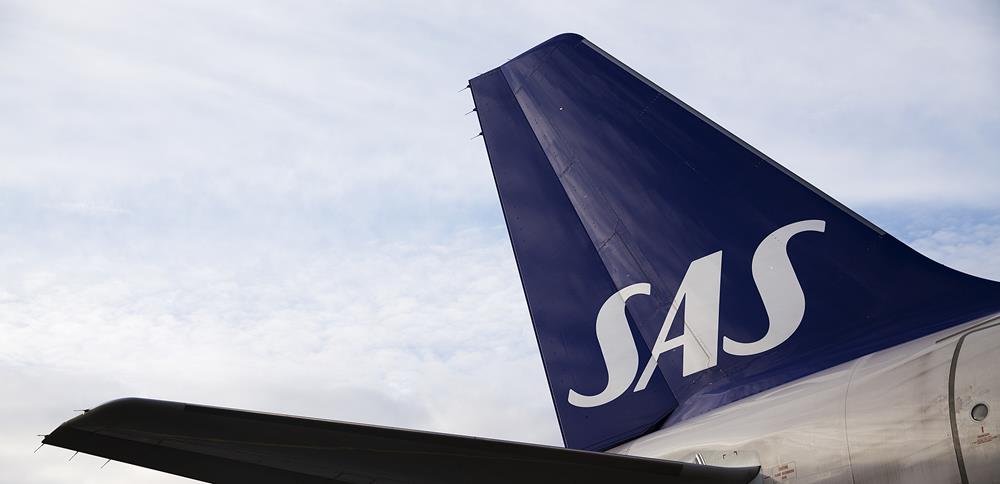Moody’s downgrades SAS’ CFR to Caa1, outlook negative
Frankfurt am Main, March 19, 2021 — Moody’s Investors Service, (“Moody’s”) has today downgraded the corporate family and probability of default ratings of SAS AB (`SAS´) to Caa1 / Caa1-PD from B3 / B3-PD respectively. SAS’ Baseline Credit Assessment (BCA) has been downgraded to caa2 from caa1. Concurrently the agency has downgraded SAS Denmark-Norway-Sweden’s backed senior unsecured MTN programme rating to (P)B3 from (P)B2 and the instrument rating of its Swiss Franc Perpetual guaranteed subordinated notes to Caa2 from Caa1. The outlook has been changed to negative from stable.
Today’s rating actions reflect (i) the sharp deterioration in SAS’ liquidity profile since the material capital injection by its shareholders in October last year with a need of securing additional funding sources over the next months, (ii) the weaker short term passenger traffic outlook for European airlines than anticipated back in November 2020, and (iii) the very slow start to the vaccination campaign across most European countries that make it difficult to envisage with strong confidence a meaningful reduction in infection rates for the important summer season.
RATINGS RATIONALE
SAS’ liquidity profile has deteriorated markedly over the time frame of a single quarter to 31 January 2021 with the group’s cash & marketable securities dropping from SEK10.2 billion at the beginning of the quarter to SEK4.7 billion at the end of the quarter. The deterioration in the group’s liquidity profile was exacerbated by a reduction in available backup credit lines to SEK1.1 billion from SEK2.8 billion at the beginning of the quarter.
The reduction in the group’s cash position was driven by a material cash burn pre working capital of SEK1.3 billion as passenger traffic was very weak over the 3 months to 31 January 2021 with a 84% year-on-year decline in passenger numbers during the period (~90% decline in Revenue Passenger Kilometer due to stronger short haul demand). In addition SAS faced a material working capital outflow of SEK3.7 billion stemming mainly from refunds (SEK2.1 billion), severance payments (SEK0.4 billion) as well as SEK0.3 billion. SEK0.9 billion of additional working capital outflows were not detailed specifically by SAS.
SAS is working on several initiatives to strengthen its liquidity profile including negotiations of deferred payments with suppliers, aircraft financing, sale & lease back as well as straight aircraft sale. The company has indicated on its earnings call that it expects to have sufficient liquidity based on a traffic recovery curve that foresees passenger demand reaching 10% to 20% of 2019 levels from February to April, 30% from May to June, 50% from July to August and 50% to 60% from September to October. The company did not present any alternative measures to boost its liquidity profile in case the traffic recovery falls short of the pattern presented above.
The passenger outlook for European airlines has deteriorated since our last rating action on SAS in November 2020. The second wave of the virus has led to a sharp increase in infection rates during the fourth quarter and into Q1 2021 leading to a sequential decline in passenger traffic for SAS. The company reported a 42% decline in Available Seat Kilometers between October 2020 and January 2021. Whilst infection rates have come down over the first few weeks of 2021 across many European countries as a result of broad based lockdown measures, we have seen an acceleration in infection rates since late February — beginning of March pointing to the risk of a third wave of infections. As a result we expect the passenger traffic outlook for European markets to be very subdued for the first half of calendar year 2021 at least. We also remain cautious on the strength of the recovery expected by most European airlines for the summer season with the consensus view being that passenger traffic between July and September will reach between 40% and 60% of 2019 levels. As such we deem risky to base an airlines’ liquidity planning on a recovery of passenger traffic to 50% of 2019 levels during the summer season. Our view of the long term recovery in credit metrics of SAS is not materially impacted by our weaker short term outlook and today’s rating action is much more driven by the group’s weakening liquidity profile resulting in the necessity of taping additional funding sources over the next months.
Vaccination campaigns across most European markets excluding the UK have seen a very slow start both due to the low availability of vaccines from producers but also to logistical challenges in many countries. The recovery in passenger traffic by the summer season is predicated on a material acceleration of the vaccination campaigns to reach herd immunity across Europe by the third quarter. The recent suspension of the AstraZeneca vaccine across many European markets is a material set back in this regard both in terms of a needed acceleration of the vaccination campaigns but also in terms of consumer confidence in this important vaccine. Beyond the suspension, AstraZeneca has also announced a material reduction in vaccine deliveries in comparison to the agreed quantities, which will also hold back vaccination campaigns even if the suspension is being lifted over the next few days.
We continue to apply the Government-Related Issuers Methodology for SAS following the shareholder’s (government of Sweden and Denmark) increase in their respective equity stake in SAS to around 22% each. We apply a moderate support assumption under our GRI methodology reflecting the materiality of the recapitalisation package that was offered last year but also the temporary nature of the European Commission’s framework under which the recapitalization package has been approved.
OUTLOOK
The negative outlook reflects the group’s weak liquidity profile and the risk that its liquidity cushion will erode further to an unsustainable level over the next few months. The negative outlook also reflects the risk of a challenging market environment well into the summer season.
ENVIRONMENTAL, SOCIAL AND GOVERNANCE CONSIDERATIONS
Moody’s regards the coronavirus outbreak as a social risk under its ESG framework, given the substantial implications for public health and safety.
The company’s commitments to reduce its carbon dioxide emissions are more ambitious than for most other network peers. SAS targets to reduce a 25% reduction in net CO2 emissions by 2030 (compared to 2005 levels), and a 50% reduction in net CO2 emissions by 2050.
STRUCTURAL CONSIDERATIONS
The credit facilities and notes under SAS’ medium-term note (MTN) program are issued at SAS Denmark-Norway-Sweden, a consortium whose liabilities are guaranteed by the constituent companies, namely SAS Danmark A/S, SAS Norge AS and SAS Sverige AB.
The one notch uplift from the CFR for the senior unsecured medium term notes reflects the material amount of subordinated capital (SEK6 billion new State hybrid and CHF127 million subordinated loan) providing loss absorption to the senior unsecured creditors.
The Caa2 rating of the CHF200 million perpetual subordinated notes (CHF127 million outstanding) is one notch below the CFR, reflecting its legal subordination to other senior secured and senior unsecured debt in the capital structure but its contractual seniority to the State subordinated hybrids.
FACTORS THAT COULD LEAD TO AN UPGRADE OR DOWNGRADE OF THE RATINGS
In light of the challenging operating environment we do not foresee short term positive rating pressure. Longer term positive rating pressure would build if, profitability is improved and gross leverage as measured by Moody’s adjusted debt/EBITDA would drop sustainably below 6.0x and positive free cash flow generation, supporting a further strengthening of the company’s liquidity profile.
The ratings of SAS could be lowered if the issuer’s liquidity profile deteriorates further.












